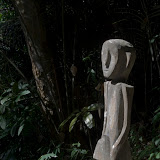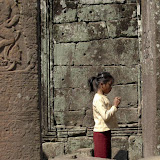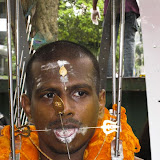Recently went on an off-the-beaten-path adventure in the jungles of Malaysia. We took a bus from Singapore to Kuala Lumpur. The bus ride itself was part of the adventure, because we booked on an "executive coach" promising personal entertainment sets, massaging chairs, food & beverage services and leather seats. Sounds glamorous, no? Well, not really. When you wipe the arm rest of the seat with an antiseptic cloth, a lighter streak reveals that the seat is actually totally covered in grime. You cannot feel the "massage" either because the bus itself vibrates/rattles so much. The food was slightly worse than airplane food, and in order to enjoy the entertainment system you need bring your own headset (because you won't want to use the ones they provide)! Anyway, still faster and cheaper than any airline, so we endured the 5 hour ride in anticipation of a relaxing weekend in the jungle.
In KL, we rented a car from Hertz - a locally manufactured car called a Proton Waja. Not too bad considering the jalopy of a taxi we rode to get from the bus stop to the rental place. I got a bit nervous about the stickers on the dashboard that were a dead-giveaway that this was a rental, and therefore a potential prime target for thiefs and crooks. Darin did a great job of driving through the mad and very confusing traffic of KL at rush hour on a Friday where they tend to change the directions of lanes as needed. Of course, you cannot see this on a map, so a two way street suddenly turns into a one-way street and before you know it, you are jam-packed and stuck in traffic with thousands of devotees on their way to prayers at the mosque.
We drove about an hour north of KL to a little tiny town called Serendah. From there, we took a few (very scenic) meandering dirt roads into the boonies, past 2 Orang Asli villages to the retreat in the jungle. The Orang Asli are the indigenous minority peoples of Peninsular Malaysia. The name is a Malay term which means 'original man' or 'first peoples.' (Incidentally, Orangutan is a Malay word, and means "man from the forest"). They (the Orang Asli, not the Orangutans) still live in simple, often delapidated shacks with no sign of electricity or facilities such as toilets or running water.
Two little scruffy looking boys standing by the side of the road, surprised us by throwing a big rock at our car as we slowly drove by. We didn't stop, but we heard the father shouting loudly at them as we drove off in shock. I am sure the got in trouble, but luckily our Proton wasn't damaged.
 The Serendah Glass House: Sekeping Serendah is a private house/shed that is very transparent to allow you to fully enjoy the beauty of the natural environment surrounding them. The sheds are intentionally kept basic and free from lavishness. They are seen more as ‘glorified tents’ to provide basic shelter - so one step up from camping. There were these hand-made iron wire chairs everywhere that were very uncomfortable and there were a number of bugs and mosqitoes that feasted on my body, but other than that, the glass house was very comfortable, relaxing and very quiet - no tv, phone or radio. Just the basics.
The Serendah Glass House: Sekeping Serendah is a private house/shed that is very transparent to allow you to fully enjoy the beauty of the natural environment surrounding them. The sheds are intentionally kept basic and free from lavishness. They are seen more as ‘glorified tents’ to provide basic shelter - so one step up from camping. There were these hand-made iron wire chairs everywhere that were very uncomfortable and there were a number of bugs and mosqitoes that feasted on my body, but other than that, the glass house was very comfortable, relaxing and very quiet - no tv, phone or radio. Just the basics.We had a great time just getting away from it all, cooking food on an open fire, listening to the sounds of the jungle, catching up on napping and reading, and being awakened at dawn by the sunlight pouring in through the glass walls.






